Market Outlook for Next Week: Key Triggers from Q3 Results, Economic Data, and FII Activity
Explore the market outlook for next week, with key triggers including Q3 earnings results, GDP data, FII activity, and economic trends. Stay updated on how these factors will influence market movements and investment strategies.

As we move into the second week of January, the market outlook for next week is expected to be influenced by a variety of factors, including the upcoming quarterly results for the October-December period (Q3), foreign institutional investor (FII) activity, crude oil prices, and key domestic economic data.
These elements will be pivotal for traders and investors, helping to determine the direction of the stock market in the upcoming days.
Table of Contents
Q3 Earnings to Drive Market Sentiment
One of the most significant factors that will shape the market in the coming week is the announcement of Q3 earnings. The results for the October-December quarter will start coming in early next week, with major IT companies such as TCS and Tata Elxsi set to release their earnings on January 9, 2025. These results are particularly important as the IT sector plays a crucial role in the Indian stock market. A strong performance from these giants could boost investor confidence and fuel market rallies, while any disappointing results could lead to market corrections.
Domestic Economic Data: GDP Estimates to be Released
In addition to the earnings reports, domestic economic data will be another critical trigger for market movements next week. On Tuesday, the government will release its first advance estimates of GDP for the financial year 2024-25. The GDP estimates will offer insights into the overall economic health of the country and could have a significant impact on market sentiment, depending on whether the data meets, exceeds, or falls short of expectations.
Crude Oil Prices and Global Market Conditions
While the focus remains on domestic factors, global developments, particularly the price of crude oil, will continue to influence market behavior. Crude oil is a key factor for inflation and economic growth in India, and any significant fluctuations in oil prices could have wide-reaching consequences for sectors such as automobiles, aviation, and energy.
Moreover, the global market activity is expected to resume normalcy next week after the lull caused by the Christmas and New Year holiday season. With institutional and retail investors returning to the markets, there could be an uptick in trading volumes, which could amplify market movements.
Market Performance in the Past Week
The Indian stock market saw a sharp rally in the week gone by, with Nifty rising by 191 points (0.80%) to close at 24,004 and Sensex gaining 524 points (0.67%), closing at 79,223. The rally was fueled by smallcap and midcap stocks, which outperformed largecap stocks during this period. The performance of small and mid-sized companies indicates that the bullish sentiment in the market remains strong, especially as the market enters the New Year.
Also Read | Indian Stock Market Opens Lower: Nifty Below 24,150
Sectoral Performance and Investor Sentiment
Looking at sectoral performance, the Nifty Auto index was the clear winner, rising by 4% over the past week. This strong performance was driven by optimism in the automobile sector, which benefited from positive sentiment surrounding the festive season and growth expectations for the new year. On the flip side, the Nifty Realty index was the worst performer, underperforming the broader market and emerging as the top laggard for the week.
Investor sentiment remained positive despite the global market activity being muted due to the Christmas and New Year holidays. The lack of significant economic data releases from major global economies left investors focusing primarily on domestic factors, particularly the upcoming earnings reports and economic data.
FIIs and DIIs: A Key Factor in Market Movements
Foreign Institutional Investors (FIIs) played a crucial role in the market last week, although their net movement was somewhat negative. Between December 30 and January 3, FIIs sold shares worth Rs 11,041 crore in the cash market. In contrast, Domestic Institutional Investors (DIIs) were net buyers, investing Rs 9,253 crore during the same period. This suggests that domestic investors continue to have a positive outlook, even as foreign investors remain cautious, possibly due to global uncertainties and other macroeconomic factors.
Technical Analysis: Nifty Forms Strong Base
From a technical analysis perspective, Nifty has formed a solid base within the 23,500-23,700 range, consolidating within this zone for the past 10 sessions. This indicates a potential bottom formation and could signal a reversal of the recent bearish trend. The sustained close above the key psychological level of 24,000 is another positive sign, adding to the bullish sentiment in the market.
Traders and analysts are now focused on a buy-on-dips approach, as the risk-reward ratio appears favorable in the current market environment. The formation of a strong base suggests that the Nifty could rise further if it manages to maintain above the 24,000 level, but any significant dips could be seen as buying opportunities by investors.
